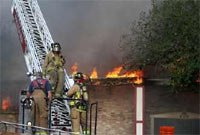LONE STAR SALOON CAMO REPLACEMENT The owner of the Lone Star Saloon in Richmond says he’s going to demolish what remains of the 120-year-old building at 102 and 106 S. Third St. and build a “gorgeous” new 4,000-sq.-ft. nightclub in its place. A fire last November gutted the brick structure and destroyed displays of American Indian memorabilia collected and installed by the previous owner. “[Bill] Lindquist, who owns the Lone Star along with his wife, Beverly, said last month he will rebuild the Lone Star as a large one-room nightclub, with a bandstand, dance floor, large modern bar and a kitchen. . . . ‘It’s going to be a metal building, camouflaged not to look like a metal building,’ Lindquist said.” [FortBendNow, via Hair Balls]
Tag: Fire
 Reflecting on the recent attention drawn to State Rep. Hubert Vo‘s tenement-quality apartment complexes — as well as three more local value-priced apartment structures that burst into flames over the last few days — local blogger Slampo says the quintessential Houston residence is finally getting the attention it deserves:
Reflecting on the recent attention drawn to State Rep. Hubert Vo‘s tenement-quality apartment complexes — as well as three more local value-priced apartment structures that burst into flames over the last few days — local blogger Slampo says the quintessential Houston residence is finally getting the attention it deserves:
We’ve long contended—in barrooms, on Metro buses, while walking our dog late at night—that the signature Houston residence is not the River Oaks mansion or the Heights cottage or the Westbury suburban rambler or the Randall Davis “loft†apartment or the Pulte Home in the Outer East Jesus Subdivision (we just love the ones with paddle boats on the man-made “lakesâ€) but rather the one- or two-bedroom unit in a two-story complex, usually but not always situated outside The Loop, that was constructed anytime from the late 1960s through mid-’80s and whose population typically has gone through one or more pronounced demographic shifts: say, from all-white to mixed to mostly black to predominantly Hispanic . . .
Slampo also makes note that Houston Chronicle readers online have taken up reporter Matt Stiles’s suggestion to identify similar “problem properties” around town:
The finely detailed and descriptive comments affixed to Stiles’ posting confirm that there’s nothing like the topic of “crappy apartments†to arouse the local populace. You don’t have to be a really perceptive sort to see that many of the bright-line social divisions in Houston—over crime, schools, “changing†neighborhoods—neatly align with the divide between apartment renters and owners of single-family homes and townhouses (and while race and/or ethnicity is a factor in these divisions, class is the underpinning). This is partly due to the proximity of subdivisions to sprawling complexes, a phenomenon that we assume is somehow linked to the city’s lack of zoning (but one that, come to think of it, we’ve noticed in other, newer-type Sunbelt cities). But mostly it’s because landlords allow these places to go down the toilet and become magnets for crime and gangs.
After the jump, that list of low-cost apartments Chronicle readers have come up with. And some of them still have vacancies!

